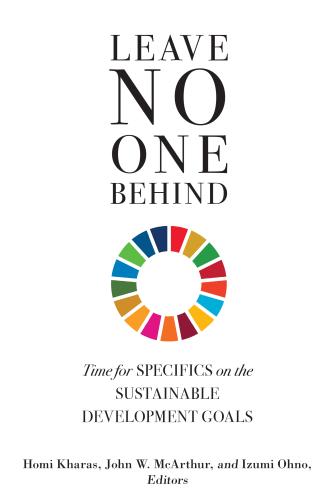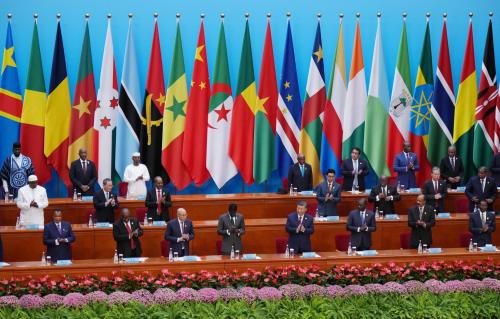World leaders are gathering in New York this week to attend the first major stocktaking summit on the Sustainable Development Goals (SDGs). When the SDGs were agreed by all countries in 2015, they were intended to help countries accelerate their transition to more sustainable paths by 2030, with sustainability understood to include economic, environmental, and social issues. As part of this, all countries committed to “leave no one behind (LNOB),” a broad promise to address the pervasive and damaging problems of inequality and exclusion. The 2015 SDG agreement even doubled down on this commitment through a pledge to “reach the furthest behind first.”
All good as words, but much harder to deliver in practice. In the sphere of global development cooperation and poverty reduction, governments and official agencies often deploy the rhetoric of LNOB but revert to traditional development strategies in their programming. To make LNOB into a practical agenda, this tendency must be confronted. This is why we, together with colleagues at the Japan International Cooperation Agency and other partners, collaborated on a new edited volume, Leave No One Behind: Time for Specifics on the Sustainable Development Goals. We thought it time to showcase ideas that could help shift LNOB from admirable slogan to practical approach.
Considerable progress has been made on raising average living standards for much of humanity, but tackling inequality and exclusion is no small task and there are fewer big success stories to draw upon. Inclusion requires addressing complex drivers of social outcomes. It demands attention on the underlying reasons why highly marginalized people are being left behind in the first place. It suggests a shift from big picture thinking about national or regional trends to much more precise thinking about the challenges faced by individual people in the communities where they live.
Simply put, an LNOB agenda is not necessarily synonymous with a national development agenda. To illustrate the point, consider the example of Canada. It is a country that has made huge achievements in its long-term national development, but still faces profound LNOB challenges, as one of us has shown elsewhere. Even if driven by overall good intentions, government systems may bolster average national progress while doing far too little for many groups and individuals.
The LNOB challenge is particularly salient when thinking about global efforts for the SDGs because so much international cooperation has traditionally been channeled through governments and elite-dominated social structures. The powers that be, whether governments or economic elites, often have vested interests in system inertia, either through inadvertent neglect of the disadvantaged or by intentionally using their position to further their own interests. Public distrust of government varies tremendously around the world and is a problem in many countries, according to the Edelman Trust Barometer, especially in places like South Africa, Spain, and Brazil. A recent Pew Research Center poll also found that the share of people responding that the U.S. government is run by a few big interests looking out for themselves has risen from 29 percent in 1964 to 76 percent in 2018.
Our book highlights the scale of the challenge for no one to be left behind. It shows that on indicators related to life and death and personal well-being, where there is reasonably comprehensive global data, progress is still far too slow to meet the SDGs and the scale of interventions needs to be sharply accelerated. In fact, as we have highlighted elsewhere, some 44 million lives are at stake and there is little evidence as yet that the rate of progress on development indicators is changing fast enough. Worryingly, the evidence on some key inputs into development, like the volume and cross-country allocation of aid, is actually getting worse. The neediest countries are getting less international support.
The need for Specific Development Goals
At the same time, the global development community must also target its interventions better and be more specific about what outcomes are to be expected from any given project or program. We argue that the best way to put teeth into the LNOB agenda, both domestically and internationally, is to reframe the relevant SDG targets more precisely—on specific people facing specific problems in specific places. Our book is not comprehensive but suggests a way of designing the questions to be more actionable. How do we achieve gender equality by 2030; how do we improve the lot of the ultra-poor; what works for small-holder farmers; how to resolve problems faced by refugees and migrants; what leapfrogging opportunities are available to deliver quality education; are options for universal health care realistic; how to make sure women participate in new technologies for accessing financial services; what are the trade-offs in using domestic taxes to finance pro-poor transfers; can we identify poverty hotspots and develop better place-based policies; how should we manage approaches to fragile contexts; can we bring city leadership on board; and what can be done to redistribute power.
The book is not intended as a complete review of all the people, problems and places that need to be addressed to fulfill the LNOB pledge. But it does draw attention to the need for specific strategies and actions. That said, many of the chapter authors recognize the interdependence between success in one area and success in another. They point to the tension between solving specific problems and getting trapped into faulty policy and program segmentation. They also point to the difficulties in getting to specifics because of the dearth of adequately disaggregated data. Building a sound empirical foundation is essential for LNOB success.
Is it overly optimistic to think, in today’s fraught global context, that countries might cooperate on LNOB? Public opinion in many countries still supports the idea of expanding international collective efforts to alleviate suffering. Even amid the intense domestic debates across the United States, recent polling by the University of Maryland’s Program on International Policy Attitudes shows a strong foundation of global compassion. Americans do not look to foreign aid to help themselves—for example in jobs or improved national security—but to solve specific problems for others who are less fortunate. When a concrete issue is presented with a price tag showing how the burden can be shared with other countries, Americans are very willing to spend more, even if it means their taxes would go up.
The general point seems to be that clear, crisp goals with specific outcomes and strategies for collective contributions can elicit strong and widespread support. These are key ingredients for shifting the LNOB mantra from words to results. It’s time to focus on specific people, living in specific places, facing specific problems. We hope that the U.N. Summit, and efforts like our book, will help move the agenda this way.
The Brookings Institution is committed to quality, independence, and impact.
We are supported by a diverse array of funders. In line with our values and policies, each Brookings publication represents the sole views of its author(s).







Commentary
Getting specific to leave no one behind
September 23, 2019